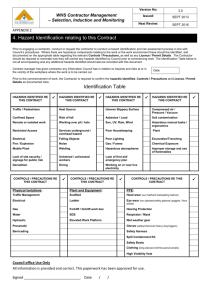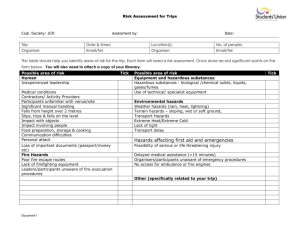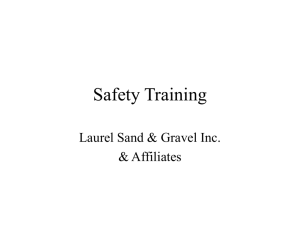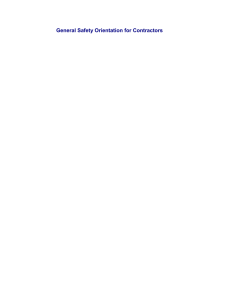Project Risk Assessment form - Facilities Management
advertisement
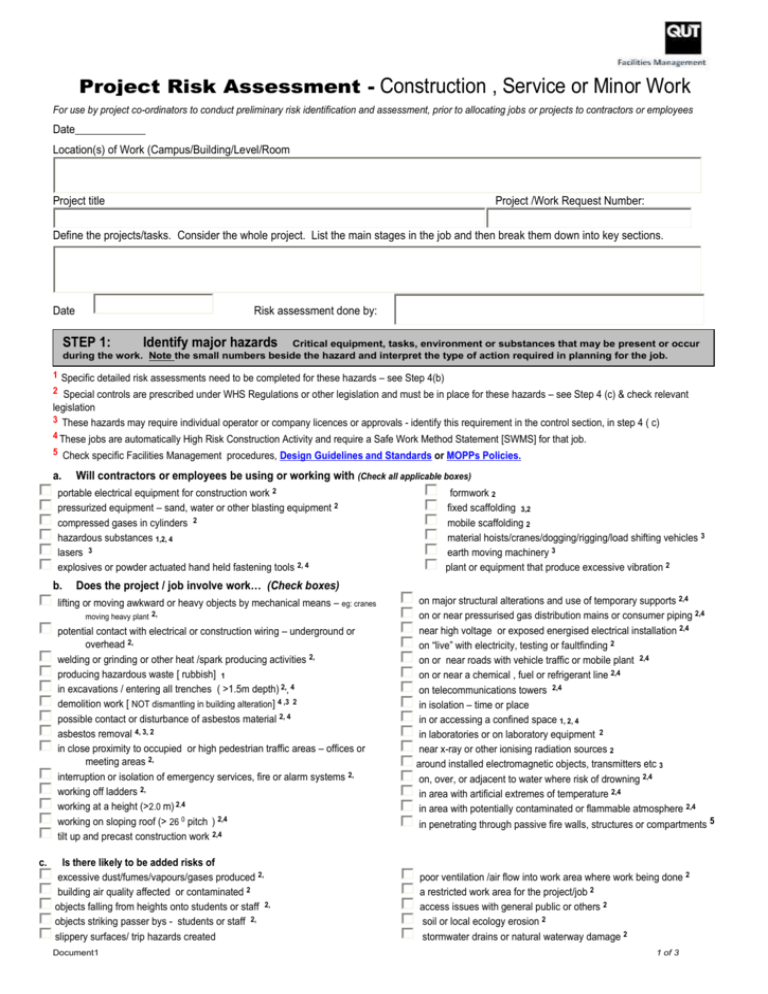
Project Risk Assessment - Construction , Service or Minor Work For use by project co-ordinators to conduct preliminary risk identification and assessment, prior to allocating jobs or projects to contractors or employees Date____________ Location(s) of Work (Campus/Building/Level/Room Project title Project /Work Request Number: Define the projects/tasks. Consider the whole project. List the main stages in the job and then break them down into key sections. Date Risk assessment done by: STEP 1: Identify major hazards Critical equipment, tasks, environment or substances that may be present or occur during the work. Note the small numbers beside the hazard and interpret the type of action required in planning for the job. 1 Specific detailed risk assessments need to be completed for these hazards – see Step 4(b) 2 Special controls are prescribed under WHS Regulations or other legislation and must be in place for these hazards – see Step 4 (c) & check relevant legislation 3 These hazards may require individual operator or company licences or approvals - identify this requirement in the control section, in step 4 ( c) 4 These jobs are automatically High Risk Construction Activity and require a Safe Work Method Statement [SWMS] for that job. 5 Check specific Facilities Management procedures, Design Guidelines and Standards or MOPPs Policies. a. Will contractors or employees be using or working with (Check all applicable boxes) portable electrical equipment for construction work 2 pressurized equipment – sand, water or other blasting equipment 2 compressed gases in cylinders 2 hazardous substances 1,2, 4 lasers 3 explosives or powder actuated hand held fastening tools 2, 4 b. Does the project / job involve work… (Check boxes) lifting or moving awkward or heavy objects by mechanical means – eg: cranes moving heavy plant 2, potential contact with electrical or construction wiring – underground or overhead 2, welding or grinding or other heat /spark producing activities 2, producing hazardous waste [ rubbish] 1 in excavations / entering all trenches ( >1.5m depth) 2,, 4 demolition work [ NOT dismantling in building alteration] 4 ,3 2 possible contact or disturbance of asbestos material 2, 4 asbestos removal 4, 3, 2 in close proximity to occupied or high pedestrian traffic areas – offices or meeting areas 2, interruption or isolation of emergency services, fire or alarm systems 2, working off ladders 2, working at a height (>2.0 m) 2,4 working on sloping roof (> 26 0 pitch ) 2,4 tilt up and precast construction work 2,4 c. formwork 2 fixed scaffolding 3,2 mobile scaffolding 2 material hoists/cranes/dogging/rigging/load shifting vehicles 3 earth moving machinery 3 plant or equipment that produce excessive vibration 2 Is there likely to be added risks of excessive dust/fumes/vapours/gases produced 2, building air quality affected or contaminated 2 objects falling from heights onto students or staff 2, objects striking passer bys - students or staff 2, slippery surfaces/ trip hazards created Document1 on major structural alterations and use of temporary supports 2,4 on or near pressurised gas distribution mains or consumer piping 2,4 near high voltage or exposed energised electrical installation 2,4 on “live” with electricity, testing or faultfinding 2 on or near roads with vehicle traffic or mobile plant 2,4 on or near a chemical , fuel or refrigerant line 2,4 on telecommunications towers 2,4 in isolation – time or place in or accessing a confined space 1, 2, 4 in laboratories or on laboratory equipment 2 near x-ray or other ionising radiation sources 2 around installed electromagnetic objects, transmitters etc 3 on, over, or adjacent to water where risk of drowning 2,4 in area with artificial extremes of temperature 2,4 in area with potentially contaminated or flammable atmosphere 2,4 in penetrating through passive fire walls, structures or compartments 5 poor ventilation /air flow into work area where work being done 2 a restricted work area for the project/job 2 access issues with general public or others 2 soil or local ecology erosion 2 stormwater drains or natural waterway damage 2 1 of 3 risk of fire/explosion2, other_________________________________________ d. QUT University specific working on or near Heritage protected buildings on any campus 2, 5 changes to existing building or services plans 5 Step 2: Assess the risks Consider each identified hazard/risk or category of hazards Rate the level of risk for each hazard, based on the LIKELIHOOD of harm occurring, without controls in place and the most likely SEVERITY of that harm or loss. Potential consequences severity Likelihood Almost certain Likely Possible Unlikely Rare Insignificant High Medium Low Low Low Minor High High Medium Low Low Moderate Extreme High High Medium Medium Major Extreme Extreme Extreme High High Catastrophic Extreme Extreme Extreme Extreme High * For unspecified projects/jobs that present a high or extreme risk, a Safe Work Method Statement should be provided by the contractor. Step 3: Control the risks Consider how each of the hazards & risks you have identified and assessed, should be controlled using the prioritised options model at right. A.For hazards having 1 EXTRA RISK ASSESSMENT is required for 1. Eliminate the hazard 2. Keep the hazard and people apart 3. Change work methods 4. Use personal protection these high-risk hazards. hazardous substance risk assessment ( based on MSDS and site use) atmospheric testing / monitoring prior to entry confined spaces risk assessment [ if not already done B.For hazards having 2 LEGALLY REQUIRED CONTROLS have to be in place for these hazard /risks. Specific action or methods are required by WH & S laws or University safety procedures. Construction hazard control options include a combination of one or more of these and others to reduce the risk. Plan or improve special set up of work environment – layout of site Reschedule or consider timing of job /work activity Check Asbestos register for presence of asbestos material Notify/consult with building occupants about impact of planned works Temporary relocation of occupants to alternative space Substitution of substances or use less hazardous methods Arrange isolation of plant or system components , pipe work, ducting or other services with appropriate persons Use of suitable safety signage, barriers, fences or other isolation / enclosure methods to restrict unauthorised access and prevent flying /falling objects Provide site specific information local hazards &/or safe methods * Mandatory Check plant, tools, equipment or vehicles in safe working order Check competency of contractors or staff to undertake work eg: licences, training, experience etc Site Induction training for new persons /contractors * Mandatory Tag out, lockout procedure to be applied – fume cupboards etc Ensure air flow , building ventilation & quality is maintained Provide information from MSDS or chemical registers to/ from contractor Ensure use of suitable Personal Protective Equipment & clothing, safety harnesses is enforced Follow University work instructions or procedures or other plans * Mandatory Notify Security of Emergency system isolations Issue of Prescribed Work Permit – Hot work, Height/roof work, Tree felling, Confined space entry ,Working in excavations Additional emergency systems required to support this job or project first aid kit extended first aid kit special emergency or rescue procedures or plans C.For hazards having 3 safety shower/ eye wash station evacuation/ fire control - extinguishers chemical spill kit remote communication equipment others _____________________________ Prescribed Activity or Occupation – These jobs require : A. An Organisation licence /registration for the contractor business Demolition work Document1 Asbestos removal 2 of 3 B. Licences for individual operators. Refer to latest WH & S Regulations Scaffolding Class B Asbestos Removal Rigging or Dogging Earth & other load shifting machinery operation Pesticide application Operators of cranes, hoists – materials or personnel Boiler or pressure equipment operations Elevating work platforms D.For hazards having 4 Safe Work Method Statement(s) or Plans are required * For any unspecified projects/jobs that present a high or extreme risk, a Safe Work Method Statement should be requested from the contractor. Safe Work Method Statements are legally required for any job involving High Risk Construction Activities or for any other high or extreme risk projects/work as assessed in step 3. If unsure, contact the Facilities Management Senior Technical Officer Health & Safety for assistance. Step 4: Project plan to control the major risks for this job or project Summarise any specific controls and further specific risk assessments required for this job. GIVE A COPY to contractor. Details of HAZARD CONTROL action required Responsibility Signed List any specific Safe Work Method Statements required from contractor (for high risk construction activities) From which contractor 1. 2. 3. 4. To be signed by both project co-ordinator and contractor when risks controls are agreed & understood, and Safe Work Method Statements are submitted [if required. ] Project co-ordinators signature Print name Date Contractors signature To evaluate Safe Work Method Statements received from contractors, use SWMS Check sheet or Project safety plan check sheet. Document1 3 of 3

